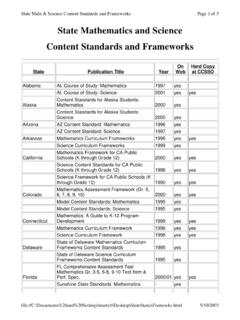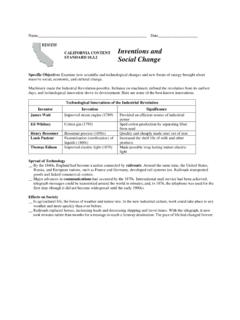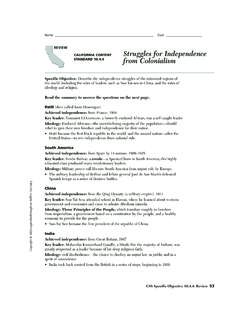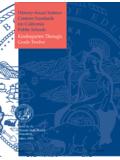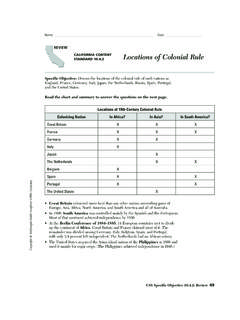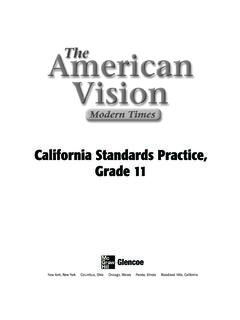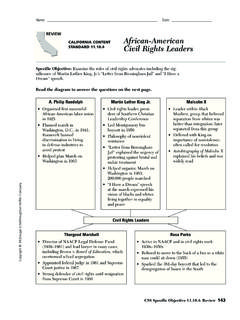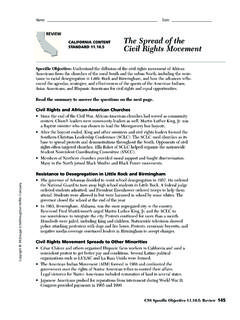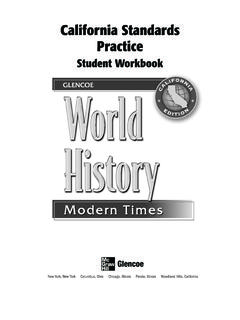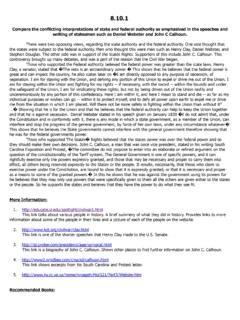Transcription of The Superintendent’s Quality Professional Learning Standards
1 The superintendent sQuality Professional Learning StandardsApproved by the State superintendent of Public InstructionProfessional Learning Support Division california Department of Education November 2014 Revised March 2015iA Message from the State superintendent of Public Instruction As State superintendent of Public Instruction, I am pleased to announce my adoption of the proposed Quality Professional Learning Standards (QPLS). Greatness by Design: Supporting Outstanding Teaching to Sustain a Golden State, the Educator Excellence Task Force report sponsored by the california Department of Education and the Commission on Teacher Credentialing, identi-fies Professional Learning Standards as a cornerstone of california s Professional Learning system. Specifically, the Task Force recommended that california adopt Standards and Quality criteria for Professional Learning to guide systems at the state, regional, district, and local school levels.
2 The QPLS lay the foundation for creating a coherent set of Professional Learning policies and activities that span the career continuum of an educator, which leads to improved educator knowledge, skills, and dispositions and, ultimately, increased student Learning results. The stan-dards describe the criteria for Quality Professional Learning and point educators and stakeholders toward evidence-based elements and indicators to use when they make decisions about how to create and/or improve Professional Learning in their own systems. By adapting or adopting these Standards , educators and other stakeholders embrace a shared expectation of what Quality profes-sional Learning is and how it should be supported. Working from this common vision, everyone connected to increasing educator excellence teachers; principals; district, county, and state educa-tion agency staff; university professors; Professional Learning and technical assistance providers; and policymakers and other stakeholders can transform california s Professional Learning system into one that ensures that every student benefits from an excellent teacher and principal.
3 As we all move forward in the weeks, months, and years ahead, we learn more and more about creating and sustaining a strong Professional culture that shares responsibility for continuous improvement and increasing student achievement and well-being. The QPLS help us to use the best of what we know to focus our efforts on steady growth and support for our state s profes-sional educators. It is this investment in teachers and administrators that ensures excellence in our schools and success for students in the Golden State, particularly as we implement the new Common Core State Standards , Next Generation Science Standards , and new assessments. Tom Torlakson December 2013iiiTable of ContentsIntroduction 1 The superintendent s Quality Professional Learning Standards 2 WHAT IS Professional Learning ? 3 WHAT DOES Professional Learning LOOK LIKE? 4 HOW TO APPLY THE Quality Professional Learning Standards 5 LINKING THE Quality Professional Learning Standards TO OTHER Standards AND INITIATIVES 5 Quality Professional Learning Standards , Elements, and Indicators 7 DATA 7 CONTENT AND PEDAGOGY 10 EQUITY 13 DESIGN AND STRUCTURE 16 COLLABORATION AND SHARED ACCOUNTABILITY 19 RESOURCES 22 ALIGNMENT AND COHERENCE 25 Appendix A: Quality Professional Learning Standards and Elements 29 Appendix B: References 37 Appendix C: How the superintendent s Quality Professional Learning Standards Were Developed 4111 INTRODUCTIONI ntroductionExpert educators, both teachers and administrators, are perhaps the most important resource for improving student Learning .
4 Students depend on competent and caring educators to support them in their development and achievement. In recognition of the critical relationship between educator effectiveness and positive student outcomes, the california Department of Education (CDE) and the Commission on Teacher Credentialing (CTC) convened the california Educator Excellence Task Force, which published the report Greatness by Design: Supporting Outstanding Teaching to Sustain a Golden State (GbD). The recommendations in this report call for the development of a coherent and stable system of Professional Learning , a critical factor in improving educator capacity so that all students learn and GbD report recommends a system of Professional Learning that brings together the goals of the state, districts, and schools, as well as individual educator needs, while recognizing and addressing the unique assets and needs of california s diverse student population.
5 Specifically, the report calls for a focus on students with disabilities; students from minority cultural, racial, and linguistic subgroups; and students from low-income families ( california Department of Education, 2012, p. 53). The report also stresses that Quality Professional Learning must provide a continuum of opportunities for educators to learn and practice skills that advance expertise throughout their careers, from preparation through expert superintendent s Quality Professional Learning Standards (QPLS) present the elements of a Quality Professional Learning system that, if well implemented, will benefit educators focused on increasing their Professional capacity and performance. The Standards are not meant to be used to evaluate any educator in any aspect of his or her work. Rather, the QPLS are intended to help educators, local educational agencies, and the state develop and contextualize Professional Learning system goals and superintendent S Quality Professional Learning STANDARDSThe superintendent s Quality Professional Learning StandardsProfessional Learning Standards are the cornerstone of Quality Professional Learning , identifying essential elements of Quality Professional Learning that cut across specific content knowledge, pedagogical skills, and dispositions.
6 The QPLS serve as a foundation for the content, processes, and conditions essential to all educator Professional Learning . The superintendent has identified the following seven interdependent Professional Learning Standards to promote Quality teacher Learning and development: DataQuality Professional Learning uses varied sources and kinds of information to guide prior-ities, design, and assessments. Content and PedagogyQuality Professional Learning enhances educators expertise to increase students capacity to learn and thrive. EquityQuality Professional Learning focuses on equitable access, opportunities, and outcomes for all students, with an emphasis on addressing achievement and opportunity disparities between student groups. Design and StructureQuality Professional Learning reflects evidence-based approaches, recognizing that focused, sustained Learning enables educators to acquire, implement, and assess improved practices.
7 Collaboration and Shared AccountabilityQuality Professional Learning facilitates the development of a shared purpose for student Learning and collective responsibility for achieving it. ResourcesQuality Professional Learning dedicates resources that are adequate, accessible, and allo-cated appropriately toward established priorities and outcomes. Alignment and CoherenceQuality Professional Learning contributes to a coherent system of educator Learning and support that connects district and school priorities and needs with state and federal requirements and seven QPLS represent essential components of a comprehensive, research-based, Quality Professional Learning system that is appropriate for california . Each broadly stated standard is made more concrete by identifying three to five major elements that are building blocks of the standard. For each element, indicators further detail what Quality Professional Learning looks like in practice.
8 Each of these Standards , along with its corresponding elements and indicators, is described in more detail beginning on page 7. What is Professional Learning ?The GbD report draws from research and literature to distinguish between Professional develop-ment, as it has been traditionally delivered, and Professional Learning . The report explains that much of the Professional development that educators have traditionally experienced has been poorly planned and implemented and has had disappointing results. Such activities have often been externally derived and delivered, disconnected from system goals and educator practice, episodic, and not tailored to the specific needs of students, educators, and schools. Finally, even when Professional development is effective in helping educators master discrete content or instruc-tional strategies, it does not contribute to a broader process of transforming their the other hand, well-designed, research-based Professional Learning can be a primary lever for improved educator practice and student results when it is: Rooted in student and educator needs Focused on content and pedagogy Designed to ensure equitable outcomes Ongoing, intensive, and embedded in practice Collaborative, with an emphasis on shared accountability Supported by adequate resources Coherent and aligned with other Standards , policies, and programs4 THE superintendent S Quality Professional Learning STANDARDSWhat Does Professional Learning Look Like?
9 In an effective Professional Learning system, school leaders learn from experts, mentors, and their peers about how to become true instructional leaders. They work with staff members to create the culture, structures, and dispositions for continuous Professional Learning and create pressure and support to help teachers continuously improve by better understanding students Learning needs, making data-driven decisions regarding content and pedagogy, and assessing students Learning within a framework of high expectations. Teachers meet on a regular schedule in Learning teams organized by grade-level or content-area assignments and share responsibility for their students success. Learning teams follow a cycle of continuous improvement that begins with examining student data to determine the areas of greatest student need, pinpointing areas where additional educator Learning is necessary, identifying and creating Learning experiences to address these adult needs, developing powerful lessons and assessments, applying new strategies in the classroom, refining new Learning into more powerful lessons and assessments, reflecting on the impact on student Learning , and repeating the cycle with new goals.
10 (Wei, Darling-Hammond, Andree, Richardson, & Orphanos, 2009, p. 3)55 INTRODUCTIONHow to Apply the Quality Professional Learning StandardsThe QPLS present a common point of reference to help state and local educators and policymakers make decisions about Professional Learning . While each individual Learning standard is important, the Standards are designed to complement each other, as each standard represents only a segment of the comprehensive criteria describing Quality Professional Learning . Educators using the QPLS in developing and accessing Professional Learning are likely to find, for example, that a decision about adding a collaborative educator study group will trigger the need to review an earlier decision about schoolwide priorities and/or the time, money, or staffing resources available to support the new activity. Developing and sustaining Quality Professional Learning usually requires stakeholders to engage in iterative discussions to negotiate priorities and alignment.
